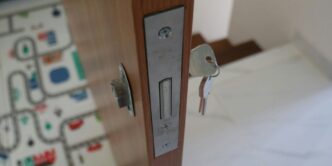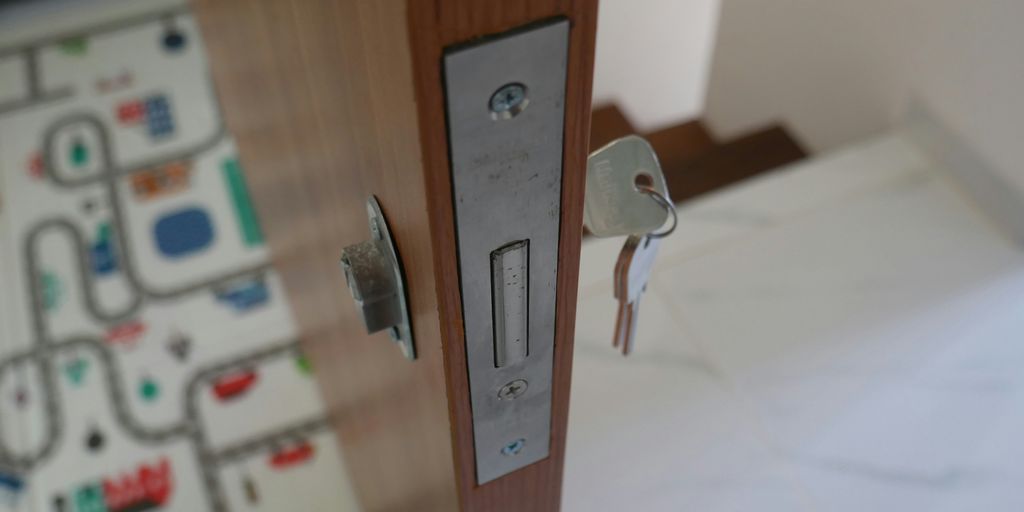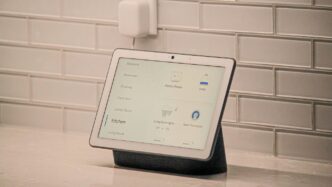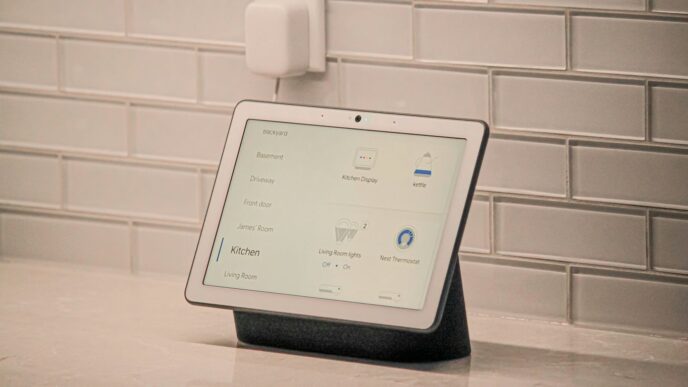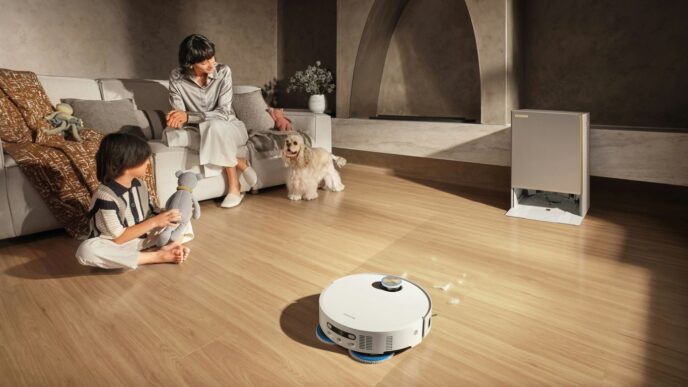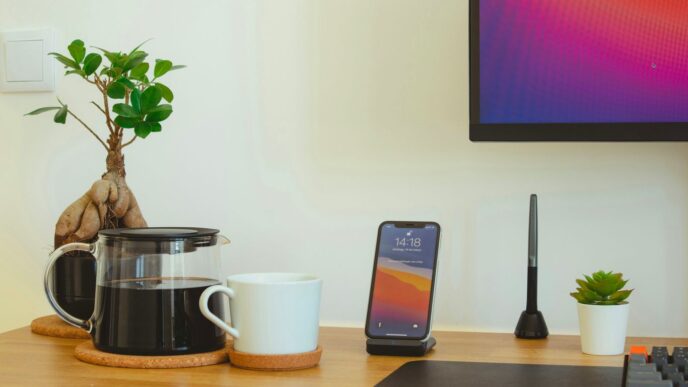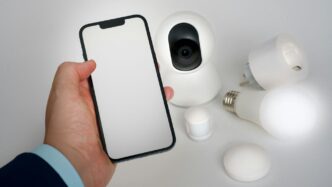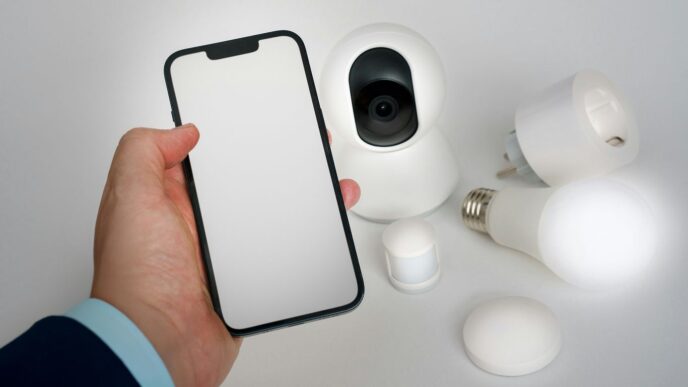This weekend, I finally switched out my old doorknob for a smart handle, and it was a bit of a pain at first. But once I got it set up, it does way more than just lock and unlock. You can get a warning if someone tries to tamper with it, have it lock itself when you walk away, or tap your phone to get in. Here, I share what I learned about picking the best smart door lock with handle—covering safety checks, entry methods, styles, and price points.
Key Takeaways
- Look for top security marks like ANSI Grade 1, tough hardware, tamper warnings, built-in alarms, and auto-lock when you leave.
- Choose how you get in: keypad codes, fingerprint scans, phone taps, or remote unlock from anywhere.
- Pick a handle that fits your home—sleek levers, classic shapes, built-in lights, and touch-friendly surfaces.
- Install fast by swapping your old handle, then link it to Alexa, Google Home, or HomeKit for voice and routine control.
- Find a model for every budget: basic deadbolt adapters, mid-range Wi-Fi levers, or high-end touchscreen and designer locks.
Elevate Security With the Best Smart Door Lock With Handle
Okay, so you’re thinking about upgrading your door handle to something a little smarter, huh? Great choice! But before you get caught up in all the cool features and sleek designs, let’s talk about the most important thing: security. A smart door lock with a handle isn’t just about convenience; it’s about making your home a fortress. We’re talking serious protection here.
ANSI Grade Ratings and Robust Hardware
When you’re shopping for a smart handle lock, the first thing you need to look at is the ANSI (American National Standards Institute) grade rating. This rating tells you how well the lock can withstand different types of attacks. Grade 1 is the highest, offering the best protection against forced entry. Grade 2 is good for residential use, and Grade 3 is… well, it’s there. The Schlage Encode Smart WiFi Deadbolt is a great example of a high-quality lock with excellent ratings. Don’t skimp on this! Also, check out the materials used. Solid metal construction is key. Avoid anything that feels flimsy or cheap.
Tamper Alerts and Built-In Alarms
Beyond just being tough, a good smart handle lock should also be able to tell you if someone’s messing with it. Look for models with tamper alerts that send notifications to your phone if someone tries to force the lock or remove it. Built-in alarms are another great feature. These alarms can scare off potential intruders and alert your neighbors that something’s not right. It’s like having a tiny security guard right on your door. I like the idea of pairing this with one of the best home security cameras so you can see who’s at the door.
Secure Auto-Lock and Geofencing Features
Ever left the house and wondered if you locked the door? Auto-lock features are a lifesaver. These locks automatically lock the door after a set amount of time, so you never have to worry. Geofencing is even cooler. It uses your phone’s location to automatically lock the door when you leave a certain area and unlock it when you return. It’s like magic! Just make sure the geofencing is secure and doesn’t drain your phone battery too much. The Kwikset Halo Select offers industry-leading auto-lock functionality for hands-free convenience.
Seamless Access Methods for Modern Door Handles
Okay, so you’ve got this fancy new smart door lock with a handle. Cool! But how do you actually get in? It’s not just about keys anymore. Let’s run through the different ways you can unlock these things. It’s pretty neat, actually.
Keypad and PIN Entry Options
This is probably the most straightforward. Most smart locks have a keypad where you punch in a code. It’s like an ATM, but for your house. You can usually set up multiple codes, which is great for family members or trusted friends. I like this option because it doesn’t rely on your phone or anything. Just remember the code! I write mine down in a secure spot, just in case. Some keypads even light up, which is super helpful at night.
Fingerprint and Biometric Recognition
Okay, this is where it gets a little more futuristic. Some smart locks use fingerprint scanners. You just put your finger on the sensor, and bam, the door unlocks. It’s pretty fast and secure. The Veise 7-in-1 Smart Door Lock stores 100 fingerprints, which is a lot! I’ve seen some that also use other biometric stuff, like facial recognition, but those are usually on the pricier side. The fingerprint thing is cool, but make sure your fingers are clean. I’ve had issues when my hands are wet or dirty.
Smartphone Tap and Remote Unlock
This is where the "smart" part really shines. You can unlock some smart locks with your smartphone. Some use Bluetooth, so you just have to be close to the door. Others connect to your Wi-Fi, so you can unlock the door from anywhere. Imagine you’re at work and a friend needs to drop something off. You can just unlock the door for them remotely. That’s pretty awesome. Plus, you can usually see who’s unlocking the door in the app, which adds another layer of security. I find the remote unlock feature especially useful when I’m expecting a delivery.
Style Meets Function in Smart Handle Designs

It’s not enough for a smart door lock to be secure and tech-savvy; it also needs to look good! Luckily, many models blend seamlessly into your home’s aesthetic. Let’s explore how style and function come together in these modern marvels.
Sleek Lever Finishes for Contemporary Homes
For modern homes, a sleek lever finish is a must. Think brushed nickel, matte black, or polished chrome. These finishes complement minimalist designs and add a touch of sophistication. The key is to choose a finish that matches your existing door hardware and other fixtures in the entryway. You can find options that are resistant to fingerprints and smudges, keeping them looking pristine with minimal effort. I was looking at some the other day, and the matte black ones really caught my eye. They just look so clean and modern.
Traditional Lever Styles With Tech Flair
If you prefer a more traditional look, don’t worry, there are smart handle locks for you too! These models often feature classic lever designs with a modern twist. Think about elegant curves, ornate detailing, and timeless finishes like oil-rubbed bronze or antique brass. The tech is hidden within the handle, so you get the best of both worlds. It’s like having a secret agent disguised as a regular door handle. I saw a smart door handle that looked like it came straight out of a Victorian mansion, but it had a fingerprint scanner built right in!
Integrated LED Indicators and Touch Surfaces
Many smart handle locks incorporate LED indicators and touch surfaces for a clean and intuitive user experience. LED lights can signal lock status (locked, unlocked, low battery) or guide you through the setup process. Touch surfaces allow for easy PIN code entry or fingerprint scanning. These features are not only functional but also add a touch of modern elegance to your door. Plus, they look super cool when you’re showing off your smart locks to your friends. It’s like, "Check out my door handle, it’s from the future!"
Effortless Installation of Smart Door Locks With Handles
Okay, so you’ve got your shiny new smart door lock with a handle. Now comes the part that might seem a little scary: installing it. But honestly, it’s usually not as bad as you think. Most of these things are designed for DIY installation, meaning you shouldn’t need to call a professional. I mean, who wants to pay someone else when you can do it yourself, right?
Removing Old Hardware and Preparing the Door
First things first, you gotta get rid of the old stuff. This usually involves a screwdriver and maybe a little elbow grease. Make sure you keep all the screws from your old handle set, just in case! You might need them later. Once the old handle and any deadbolt hardware are out, take a look at the door itself. Is it in good shape? Are the holes the right size? Sometimes, you might need to do a little bit of adjusting, like widening a hole slightly or reinforcing the door frame. It’s also a good idea to give the door a good cleaning around the handle area. You want a nice, clean surface for your new smart handle lock.
Configuring the Mobile App and Wi-Fi Bridge
While you’re at it, download the app for your new lock. Most smart locks need a companion app to work properly. This is where you’ll set up your account, connect the lock to your Wi-Fi, and configure all the settings. Some locks also come with a Wi-Fi bridge, which is a little device that plugs into an outlet and helps the lock connect to your home network. Follow the instructions in the app to get everything set up. It’s usually pretty straightforward, but don’t be afraid to consult the manual if you get stuck. The AI-powered analytics are pretty cool, right?
Adjusting Handle Alignment and Torque
Once the lock is physically installed, you’ll need to make sure the handle is properly aligned and the torque is correct. This means that the handle should move smoothly and easily, without sticking or feeling too loose. If the handle is misaligned, it can be difficult to open and close the door. And if the torque is too high or too low, it can damage the lock mechanism over time. Most smart locks have adjustable screws or settings that allow you to fine-tune the handle alignment and torque. Take your time and make sure everything is working smoothly before you button everything up. Here’s a quick checklist:
- Check handle movement.
- Adjust screws if needed.
- Test locking and unlocking.
Integrating Your Smart Handle Lock Into Home Automation
Voice Control via Alexa, Google Home, and HomeKit
Smart handle locks really shine when they work together with other smart devices. Voice control is a game-changer. Imagine telling Alexa to lock the front door as you head to bed, or asking Google Home to unlock the door for a guest while you’re busy cooking. Most smart locks play nice with popular voice assistants like Alexa, Google Home, and Apple HomeKit. This means you can control your lock, and other devices, all from one app. Just make sure to check compatibility before you buy, especially if you already have a favorite voice assistant.
Setting Up Custom Entry and Exit Routines
Beyond simple voice commands, you can create custom routines to automate tasks. For example, when you unlock the door, the entryway lights could turn on, and the thermostat could adjust to your preferred temperature. Or, when you lock the door upon leaving, the lights could turn off, and the security system could arm itself. The possibilities are pretty endless, and it’s all about tailoring your home to your specific needs. Here’s a simple example of a routine:
- Arrival Routine: Unlock door -> Turn on entryway light -> Adjust thermostat to 72°F
- Departure Routine: Lock door -> Turn off all lights -> Arm security system
- Night Routine: Lock door -> Turn off downstairs lights -> Set thermostat to 68°F
Linking to Smart Cameras and Alarm Systems
For an extra layer of security, consider linking your smart handle lock to smart cameras and alarm systems. You could set up your system so that unlocking the door triggers a camera to start recording, or if someone tries to tamper with the lock, the alarm goes off. This integration can give you peace of mind, knowing that your home is well-protected. Many systems offer activity logs, so you can review who’s accessed your home and when. This is especially useful if you give temporary access to friends or family.
Maintaining Peak Performance of Your Handle Lock
Replacing Batteries Without Losing Settings
Smart door locks with handles are convenient, but they rely on batteries. The good news is that most models are designed to allow battery replacement without losing your settings. To ensure a smooth transition:
- Always have a fresh set of batteries on hand. Lithium batteries generally offer better performance and longevity compared to alkaline.
- Check your lock’s app for low-battery warnings. Don’t wait until the last minute to replace them.
- Follow the manufacturer’s instructions carefully when replacing the batteries. Some locks have a specific sequence to prevent data loss.
Updating Firmware for New Features
Just like your smartphone, your smart handle lock receives firmware updates. These updates often include:
- Security patches to protect against vulnerabilities.
- New features and functionalities.
- Performance improvements and bug fixes.
Make sure to regularly check for updates in your lock’s mobile app and install them promptly. Ignoring updates can leave your lock vulnerable. It’s a good idea to enable automatic updates if that’s an option. This ensures your smart sensors are always running the latest software.
Troubleshooting Common Connectivity Issues
Smart locks rely on a stable Wi-Fi connection to function correctly. If you experience connectivity issues, here are some troubleshooting steps:
- Check your Wi-Fi router. Make sure it’s powered on and connected to the internet. Restarting your router can often resolve temporary connectivity problems.
- Verify the distance between the lock and the router. If the lock is too far from the router, the signal may be weak. Consider moving the router closer or using a Wi-Fi extender.
- Interference from other devices. Cordless phones, microwaves, and other electronic devices can interfere with Wi-Fi signals. Try moving these devices away from the lock and router.
- Check the lock’s app for error messages. The app may provide specific troubleshooting steps for common connectivity issues. If all else fails, contact the manufacturer’s customer support for assistance. Remember to keep your smart door lock in good working order!
Comparing Budget-Friendly and Premium Smart Handle Locks
It’s time to talk money! Smart door locks with handles come in a wide range of prices, and understanding the differences between budget and premium options is key to making the right choice for your home. Let’s break down what you get at different price points.
Affordable Deadbolt Adapters
These are your entry-level options. Think of them as smart lock ‘add-ons’ rather than full replacements. They typically work by retrofitting your existing deadbolt, which means you don’t have to replace the entire handle and lock mechanism. This can save you a lot of money upfront.
- Pros: Lower cost, easier installation (usually), and compatibility with existing hardware.
- Cons: May lack advanced features like fingerprint recognition or integrated alarms. The aesthetic might not be as sleek as dedicated smart handle sets. They can also be a bit bulky.
- Example: August Smart Lock (retrofit model).
Mid-Tier Wi-Fi Lever Handles
Stepping up a level, you’ll find smart lever handles that offer a good balance of features and price. These usually replace your entire existing lever handle and offer direct Wi-Fi connectivity, meaning you don’t need a separate hub. You can find a good smart lever handle in this range.
- Pros: More integrated design, better security features (like tamper alerts), and remote access via Wi-Fi.
- Cons: Can be more expensive than deadbolt adapters, and installation might be a bit more involved. Battery life can vary.
- Example: Many Schlage Encode models fall into this category.
Luxury Touchscreen and Designer Models
At the top end of the spectrum are the premium smart handle locks. These boast high-end materials, sleek designs, and a full suite of advanced features. Expect to see touchscreen keypads, fingerprint scanners, and seamless integration with other smart home systems. These are the most expensive smart lock brands.
- Pros: Top-of-the-line security, stylish aesthetics, and advanced features like voice control and geofencing. Often include Apple Home Key compatibility.
- Cons: Significantly higher price tag, professional installation may be recommended, and some features might be overkill for basic home security needs.
- Example: Level Lock+ or high-end Lockly models.
## Conclusion
All in all, smart door locks with handles bring a mix of style and safety to your home. You can try a full swap like the Schlage Encode or tweak your current lock with the Yale adapter. Code entries, app controls, or even tap-to-open let you pick what works for you. Most models slide right onto standard doors and only need a screwdriver (seriously). And the best part? You won’t lose keys under flower pots again. Sure, they cost more than a plain lock, but the peace of mind and the look you get are worth it. So choose a model that fits your style, follow the simple steps, and enjoy your new, smarter front door.
Frequently Asked Questions
What makes a smart door lock with a handle different from a regular lock?
A smart lock with a handle has built-in electronics and connects to your phone or home system. You can open it with a code, a fingerprint, or an app instead of just a key.
How hard is it to install a smart handle lock on my door?
Most smart handle locks fit where your old lock was. If you can use a screwdriver and follow step-by-step instructions in an app, you can finish the job in about 30 minutes.
Can I keep using my old house key with a smart lock handle?
Yes. Many models let you use your traditional key as a backup. So if your batteries die or your phone is out of power, you still get in.
How often do I need to change the batteries in a smart handle lock?
Battery life varies, but most smart handles run for six months to a year on one set of batteries. The lock will warn you long before they die.
Are these smart handle locks safe from break-ins and hackers?
They meet tough safety standards and use strong encryption to block digital attacks. Plus, many locks send alerts if someone tries to force them open.
Can I link my smart handle lock to Alexa, Google Home, or other smart devices?
Absolutely. You can add your lock to popular home systems and then lock or unlock your door with voice commands or by tapping routines in your smart home app.

